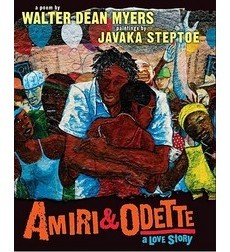 Walter Dean Myers is known for gritty novels like Monster and Shooter and Dope Sick and Sunrise Over Fallujah, and for picture book poetry collections like Jazz. This year, he's managed to combine gritty, urban teen themes with poetry . . . and ballet.
Walter Dean Myers is known for gritty novels like Monster and Shooter and Dope Sick and Sunrise Over Fallujah, and for picture book poetry collections like Jazz. This year, he's managed to combine gritty, urban teen themes with poetry . . . and ballet.Yeah, I said it. Ballet.
See, Myers was much struck with the story of the ballet Swan Lake, which you may know from, say, having seen Billy Elliot or The Swan Princess, if you haven't seen the ballet on its own. The ballet, which dates from about 1875, was based on a variety of Russian and German fairy tales involving a princess (named Odette) who is under the spell of a magical bad guy named Rothbart (German for "Red Beard"), who tries to pair his own daughter, Odile, with Prince Siegfried. Siegfried, however, loves only Odette.
The ballet comes in four acts, but the final act varies wildly:
Act 1: Siegfried must choose a bride at his birthday ball (sounds like the prince in Cinderella, yes?) He heads into the woods and chases some swans.
Act 2: Siegfried gets ready to shoot an arrow at one of the swans, then realizes she is more human than swan. He finds out she's Odette, bewitched by Rothbart to be a swan by day. Love ensues. He wants to kill Rothbart, but if he does so before the spell is broken, it will never end.
Act 3: Siegfried has his ball. Rothbart tricks him into thinking that Odile is Odette, and he pledges his love to the wrong girl.
Act 4: Back at the lake, Siegfried apologizes to Odette, who forgives him. They refuse to be parted, and kill themselves, thereby weakening Rothbart's power so much that he dies OR their love is so strong it overcomes Rothbart, who dies while they live happily ever after OR Odette is stuck being a swan forever and Siegfried is left broken and alone.
Walter Dean Myers sets this book, Amiri and Odette in the Swan Lake Projects, an urban apartment complex in an asphalt world. Javaka Steptoe, the illustrator, took Myers's idea and ran with it, literally creating collage art on slabs of asphalt and cinder block. His images include original art and the sort of objects one might use in everyday life - I spotted a menu from a Chinese restaurant, actual feathers and some of the real jewelry that Steptoe mentions in his illustrator's note.
In Myers's text, Siegfried becomes Amiri (a version of the Arabic word meaning Prince). Rothbart becomes "Big Red". And Odette? Yeah, she's still Odette. The book, like the ballet, is split into four "acts".
Act 1: His mother says she's having a party so he can find a nice girl to settle down with.
Act 2: Amiri and his friends play basketball in the night:
But on the far edge of this boy-boy dream,
As far as forever, as close as a scream,
There are girl shadows dancing
And one who is glancing
At the muscular form that leaps toward the rim.
He sees her -- she sees him.
A feeling of magic in the air.
He holds his breath,
she smooths her hair.
Act 3: At the party, Big Red sends an unidentified girl in a black swan mask to Amiri; she pretends to be Odette and he pledges his love to her. Odette, who is late to the party (I guess), shrieks and takes off, with Amiri in hot pursuit.
Act 4: Back out on the basketball court, Amiri finds Odette alone, "shivering in the dark". Odette says she's already dead, and only a specter.
"No, I am Amiri," he says.
"And what I see is a sweet promise of tomorrow.
Invent our love, and we will beat Big Red.
Without this hope, we may as well be dead."
Big Red and Amiri duke it out - with weapons - over Odette, and Big Red loses and leaves town as Amiri and Odette end up dancing in the sunrise.
And yes, I just told you the ending, but that doesn't mean you shouldn't have a look at the book, which is, as I've already mentioned, written as a poem. Myers's use of language and fluid approach to meter and rhyme is interesting, and Steptoe's use of textures and rich colors to bring the story alive visually is exciting.
Perhaps my most serious criticism of the story is Myers's decision to call the bad guy "Big Red", because it's a name I can't read without thinking of my favorite cinnamon chewing gum. Putting that aside (which I must do every. single. time. I read the guy's name), I thought this adaptation worked well. It does for Swan Lake what West Side Story did for Romeo and Juliet: brought it forward in time and made it seem fresh and relevant.

2 comments :
This sounds wonderful - is all of the artwork like what's on the cover? It looks so vibrant and alive. And "Swan Lake Apartments"? Brilliant.
The artwork inside is every bit as vibrant and alive as the cover art - even more so, in many cases. I really wish I could've found images online to share - they're really cool. In addition to the saturated colors, you can see the texture in them really well, too.
Post a Comment